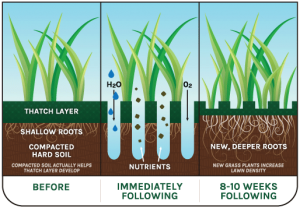You know by now that up to 70% of your water use is outdoors. Strict water conditions are tough on everyone, especially our lawns. Although we do our best to be responsible and conservation-minded when it comes to lawn care, there are some measures you may not know about to keep your lawn healthy when water shortages hit.
Raise the mower blades. Raise your lawn mower blades 25%-50%. Cutting the lawn too short during a drought prevents grass from storing water. Longer grass blades aid in photosynthesis. BONUS TIP: sharpen your mower blades once a month during the summer. Dull blades tear at the grass, rather than cutting it cleanly, causing grass to use more water to recover.

Aerate. Aerating, digging small holes in the soil, will improve water flow to the roots of your lawn. Aerating loosens compacted soil, making it easier for water and air to reach your grass’s roots.
Dethatch. Thatch is the dead blades of grass and other plant material lying on the top of your lawn. If not removed regularly, it can suffocate your lawn. Thatch, in most circumstances, is beneficial to your lawn, but in times of drought it can make a difficult situation worse.
Reduce foot traffic. Lawns, like carpets or rugs, take a beating from foot traffic. Try not to use your lawn as a soccer pitch, or reduce yard activities to cut down on your lawn’s stress.
For more great lawn care tips, visit our Landscape Care resource page.
From time to time, Water – Use It Wisely features guest bloggers who write about topics related to water and water conservation. Brendan Gill is a writer and marketing expert at SERVIZ, an on-demand home services company specializing in water-saving services such as checking for leaks, low flow showerheads and aerators, proper water pressure and more. You can view Serviz’s original blog post here.


